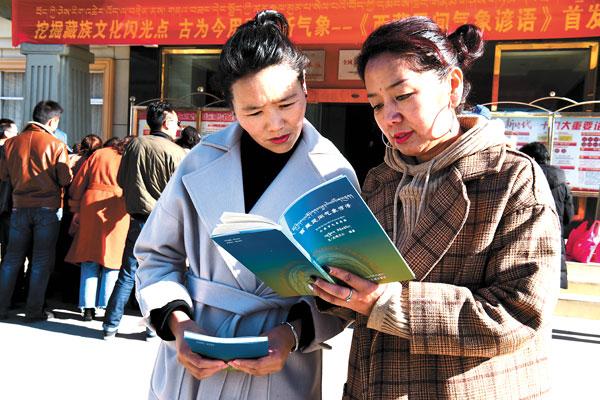Folk meteorological proverbs collected in Tibet

The research project team collects folk meteorological proverbs in Burang County, Ngari Prefecture.

Two urban residents are reading Tibetan Folk Meteorological Proverbs.
The first publication of Tibetan Folk Meteorological Proverbs (Tibetan edition) is of great significance to the preservation and inheritance of Tibet’s incredible traditional culture.
Meteorological proverbs are empirical idioms that are summed up by our people during long-term production and living practices, and they are spread far and wide throughout folk culture. The language of folk meteorological proverbs is concise, catchy, and rich in folklore. The proverbs play an important role in helping people predict common weather and climate trends, guide agricultural production, and help understand the laws of nature.
In order to better preserve and inherit the traditional culture of Tibetan folk meteorological proverbs, in 2016, the Tibet Autonomous Region Meteorological Bureau launched a research project to collect and publish them.
Countless folk meteorological and agricultural production proverbs have circulated throughout Lhoka, the cradle of the Tibetan people and birthplace of Tibetan culture, since ancient times. Naturally, this makes the region the “main battlefield” for collecting meteorological proverbs. Since August 2016, the Lhoka Meteorological Bureau has organized experts to visit 685 townships and 72 counties in seven prefectures across Tibet, interviewing more than 200 elderly people over the age of 60 who are most familiar with traditional Tibetan farming and nomadic culture.
The biggest problems in collecting these meteorological proverbs is finding people to interview and language barriers, because many young people are not familiar with folk proverbs, and the elderly who were familiar with them might have already passed away. Also, because Tibet is a vast region with widely various local dialects, experts were often unable to understand the dialects of elderly people from Ngari, Nagchu, and Chamdo during interviews, and had to rely first on recording interviews and then going back to find someone familiar with the local dialect to help translate.
In the end, the project team collected a large amount of data and compiled it into a booked titled Tibetan Folk Meteorological Proverbs (Tibetan language edition). The book contains more than 80,000 characters and is divided into three sections and 25 chapters, and records more than 10 different types of more than 270 meteorological proverbs about phenomena in the sky, configurations of the stars, natural habitats and activities of wildlife, plant growth, and solar periods. In addition, more than 10 traditional farming and nomadic cultural heritages, production methods, and technical skills relating to meteorology such as traditional spring plowing and sowing, harvest rituals, farmland fertilization, irrigation, autumn harvest rituals, and breeding livestock comprise a relatively complete record of folk meteorological proverbs. The project was awarded the National Meteorological Departments Innovative Project of 2017 by the China Meteorological Bureau.
Your Comment
Name E-mailRelated News
-
;
Based in Lhasa, Tibet Vista is a Tibet travel agency that specialized in Tibet permit, and Tibet tours for both private and group travelers at a local price!
•4 Days Lhasa City Group Tour from USD 460 •8 Days Everest Base Camp Group Tour from USD 850 •15 Days Mt.Kailash Group Tour from USD 1780 •2016 Tibet Train Tours from Beijing, Shanghai, Chengdu, Xining,etc










